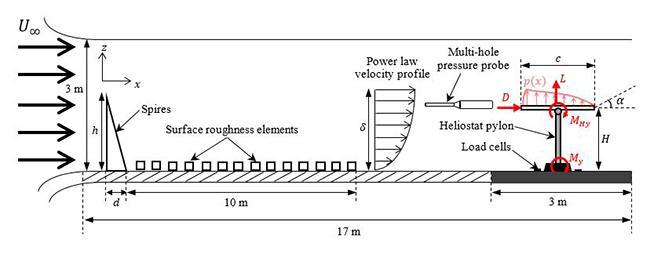Australian Solar Thermal Research Institute (ASTRI) develop heliostat wind load spreadsheet
The Australian Solar Thermal Research Institute (ASTRI), led by the University of Adelaide in collaboration with CSIRO, have developed a heliostat wind load spreadsheet.

Schematic diagram of the wind tunnel setup.
The spreadsheet estimates the design wind loads on different heliostat sizes—based on the expected wind speed and turbulence intensity profiles in the full-scale ABL and the dependence of the aerodynamic wind load coefficients on turbulence intensity—in wind tunnel experiments conducted at the University of Adelaide.
Wind load predictions for heliostats are not provided in design codes for buildings because of their non-standard shape and the changes in wind velocity and turbulence in the lowest 10 m of the atmospheric boundary layer (ABL).
Accurate estimation of the maximum wind loads on heliostats and the effect of turbulence in different terrains on the design wind loads is necessary to avoid structural failure but also reduce the cost of over-engineered structural components. The method for calculating the design loads is based on the mean wind speed and turbulence intensity with respect to the critical scaling parameters of the heliostat – mirror chord length and elevation axis height.
The maximum operational loads and the stow survival loads are defined independently with respect to their design wind speeds and turbulence intensity for the critical load cases that represent the azimuth-elevation heliostat orientations with respect to the wind. The design wind load spreadsheet is a first step toward developing wind load guidelines for heliostat developers and researchers within the SolarPACES Task III workshop.
For more information and to view the spreadsheet, click the button below.
